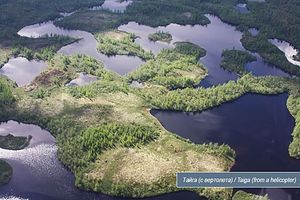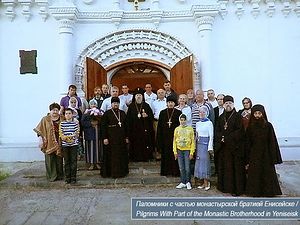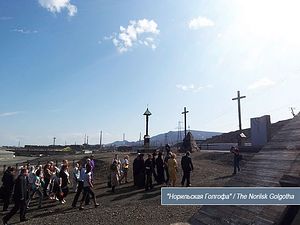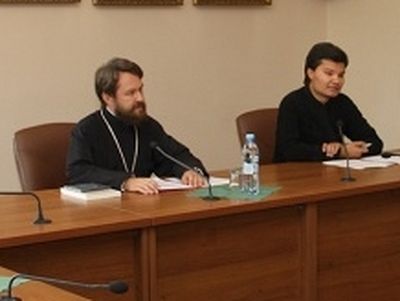Anyone who has read Alexander Solzhenitsyn's Gulag Archipelago or the works of Shalamov and other authors who have written about horrible pages from the history of Lenin's and Stalin's enslaved Russia, can probably call to mind names of Gulags, state concentration camps, such as Turukhansk, Igarka, Dudinka, and Norilsk. From July 6 to 13 of this year, and with the blessing of the Very Most Reverend Metropolitan Hilarion, First Hierarch of the Russian Orthodox Church Outside of Russia, your author and his matushka visited this part of Eastern Siberia at the invitation of the Very Most Reverend Archbishop Antony of Krasnoyarsk and Yeniseisk; the occasion of this journey was the 20th Anniversary of the rebirth of the enormous Krasnoyarsk Diocese.
On July 5, 2010, after long flights from the USA by way of Moscow, we arrived at Holy Dormition Monastery in Krasnoyarsk, where we were greeted by our host, the exceedingly hospitable Vladyka Antony, and by his deputy, Hegumen Nektary (Seleznev), administrator of the Monastery. After taking a tour of the renascent monastery and being hosted to an abundant banquet, we spent the rest of the evening resting and preparing for our trip along the Yenisei to the Northern part of the Diocese of Krasnoyarsk.
In the morning on July 6, we boarded our ship, the "Alexander Matrosov," where we were introduced to others who had been invited by Vladyka Antony to take part in this pilgrimage through the boundless expanse of the Krasnoyarsk land. Some of the pilgrims had come from Sweden and Lithuania; the rest were from Russia.
In the evening on the first day of our travels, July 7, the ship made its first stop - in Yeniseisk, one of Siberia's oldest cities, established as a military fortress in 1619 by a detachment of Cossacks. On the dock, Vladyka and the pilgrims were greeted by Abbot Nikanor (Anfilatov), administrator of the Holy Transfiguration Monastery, and by representatives of the provincial and city governments. After touring Siberia's oldest monastery and reading the evening prayer rule, the pilgrims had a lenten monastic supper. During the meal, Vladyka Antony noted what had been accomplished in the restoration of the 400-year old Monastery, the Iveron Convent, and the city's Holy Dormition Cathedral; he called upon the secular authorities to redouble their contribution to the work of restoring Yeniseisk's historical monuments.
Yeniseisk is considered the cradle of Orthodoxy in Siberia and of what is uniquely Russian in the land of Krasnoyarsk. About 70 historical, cultural, and architectural monuments have been preserved. Throughout its history, Yeniseisk was a place of exile for dissidents. Among the more famous people exiled here were Protopop Avvakum, several Decembrists, and the great Holy Hierarch Luke (Voino-Yasenetsky).
Continuing our travels along the Yenisei, our ship made brief stops at a number of settlements on the banks of the mighty river. At each of our stops, village priests and their flocks would be waiting at the pier to welcome their Archpastor. Without fail, Vladyka would find words of encouragement and consolation for each of them. We witnessed how an Archpastor shows sincere concern for his flock, and with what love for him the flock responds.
After the ship docked at the village of Turukhansk, Vladyka Anthony and the pilgrims were greeted by Abbot Agathangel (Daineko), administrator of the Holy Trinity Monastery, and by provincial and city officials. The pilgrims experienced the joy of being able to venerate one of Siberia's great holy treasures, the relics of Holy Martyr St Vasily of Mangezeisk, (+1602 ), the first person in Siberia to be glorified as a saint. His holy relics are the principal holy treasure of Holy Trinity Monastery. The Monastery, established in the mid-17th Century, is the most Northern monastery in all of Russia, and played a significant role in spreading Christianity in the Northern regions of the enormous Turukhansk land..
The administrator of Holy Trinity Monastery told us that the Monastery's liturgical life continued until 1933, when "abomination of desolation" began at this holy site, and continued to rule for another 58 years, until prayer life there was restored in 1991. The reliquary in which the relics of Holy Martyr Vasily lay was opened, and the holy remains were desecrated. The Cathedral Church of the Holy Trinity was turned into a warehouse. Among the host of New Martyrs and Confessors of Russia who were here in the 1920-30s were Bishop Athanasios (Sakharov) of Kovrov, Metropolitan Kirill (Smirnov) of Yaroslavl', and the surgeon Archbishop Luke (Voino-Yasenetsky).
Vladyka Luke's autobiography records many precious details about his time in Turukhansk. The following excerpt from the Holy Hierarch's recollections will give the reader some idea of the extremely difficult conditions the exiled hierarch and the other prisoners had to endure. Vladyka recalled that because of his resolute adherence to the Faith, one of the agents of the CheKa came to despise him with such fierce hatred that he succeeded in having him moved from Turukhansk to the even more remote taiga. In the village of Plakhino, Vladyka Luke was assigned quarters "with two windows; instead of having outer [storm windows], their exteriors were covered with flat sheets of ice. Cracks in the windows were left unsealed, and in the corner, the light of day could be seen through a large gaping crack. There was a snowdrift on the floor. At the threshold there was a second pile of snow that never melted. To provide places to sleep at night and to rest during the day, the peasants had constructed wide sleeping platforms, covered with deer hides. ...It would be freezing cold when I got up in the morning; there would be a thick layer of ice in the water bucket. When I sat, warmly dressed, at the table, I would feel warm above the waist, but would be cold below the waist."
The suffering one had to live in such harsh circumstances day in and day out, year after year. On February 15, 1954, toward the end of his life, on the thirtieth anniversary of his ordination to the diaconate, Holy Hierarch Luke said:
"My thirty-year long journey was difficult and thorny, but at the same time it was also a remarkably blessed one. God's grace was with me along the way, and my path was illumined by the light of Christ. And it is a joy for me, a very great joy, to have traveled that path. It was a great act of kindness done by God for me. I consider the difficult years of priesthood, soon followed by my service as a bishop, not as burdensome, but as the most blessed, best, happiest, years of my life."
During our four-day journey along the Yenisei, Vladyka Antony told the pilgrims many interesting things about the Yenisei, one of the greatest rivers in all the world. From South to North, it is about 3,487 km in length. Its river basin encompasses about 2,580 thousand square km. The river flows out into the Arctic Ocean. The source of the Yenisei is believed to be the Kara-Balyk lake in the Sayan Mountains. It ices over in November, and thaws in March or April. It is home to 40 different varieties of fish, ranging from pike and burbot to sturgeon and taimen.
During our four days on the mighty Yenisei, matushka and I often remembered awful scenes from The Gulag Archipelago describing how hungry, cold, tortured people were taken by barge to Stalinist camps, and how others were drowned in the river's frigid, deep and fast-moving water.
Twenty years ago, when Archbishop Antony ascended the cathedra of the Diocese of Krasnoyarsk and Yeniseisk, there were but ten churches in the enormous land of Krasnoyarsk, a land four times the size of France. Over the past two decades, more than 270 churches, chapels and houses of prayer have been built or restored in the Diocese. Among them are churches or chapels established at hospitals, penitentiaries, and at a military school. Monasteries— 3 for men and 3 for women - have been opened. Religious institutions, Orthodox social organizations, brotherhoods and sisterhoods, theological/pastoral programs of study, church Sunday schools, Orthodox cultural centers and libraries, several Orthodox grammar schools and middle schools, church and youth choirs, have all been established. The Diocese also operates a program to serve pilgrims, a press office, and a publications center.
Vladyka conducted a number of religious talks, and from time to time asked pilgrims to talk about their religious experiences. I had the honor of talking about the Hawaiian Myrrh-streaming Iveron Icon of the Mother of God. On the eve of our departure for Siberia, brother Nektary Yangston, curator of the Icon , sent us a large quantity of cotton thoroughly steeped in the grace-filled, aromatic Myrrh. (We hung up a print of the Hawaiian Icon in the ship's dining hall, and would pray before it both before and after meals. On the last day we were aboard the ship, the crew asked that the Icon remain in the dining hall.) I gave a detailed account about the appearance of the Icon in 2007, the year unification of the Russian Church was achieved, and gave each pilgrim a small piece of cotton with myrrh from the Icon. Many priests I met in the land of Krasnoyarsk received these holy things. We left most of the myrrh-steeped cotton with Vladyka Antony. Thanks to the internet, many had already heard about the Icon.
In the evening of the fourth day of our travels along the Yenisei, the "Alexander Matrosov" arrived at the port town of Dudinka. That small town is located North of the Arctic Circle and is one of the Northern-most towns in the world, and one of the coldest, with Winter temperatures dropping to -57 С). While nearing the port, we heard the peal of bells rung at the newly-erected Church of the Entry of the Mother of God into the Temple, a picturesque church on the river bank. At 9:00 pm, the travelers were greeted by the clergy and the members of the administration of the Taimyrsk Municipal Region. Vladyka Antony was presented with the traditional bread and salt and, in keeping with local tradition, fish. Representatives of the various ethnic groups of Northern Russia (Iganantsy, Dolgany, Nentsy, Evenky, and Entsy), were attired in colorful folk costumes, and welcomed their Archpastor in their native tongues.
We were taken from our pier to the airfield, and then by helicopter to the campground on the island of Lipatinokova, where we were to spend the night. We reached the campground at 11:00 PM. However, it was as light as day, as we were in the polar region at a time when the sun does not set. Upon our arrival, we got a friendly "bread and salt" welcome from the camp managers, who had prepared their archpastor and his guests a banquet fit for a king. They even gave up their own beds (and spent the night in storerooms and in the banya [Russian bath]. We were also welcomed by hosts of other inhabitants of the island — the famous Siberian mosquitoes. Fortunately, with insect repellant, we were able to deal with them.
In the morning of July 10, we had an opportunity to take in the unique scenery of the tundra, and to go fishing on the Yenisei. After lunch, we returned by helicopter to Dudinka to attend the Vigil Service at the Church of the Entrance into the Temple. Before attending the Vigil, we had time to visit the excellent Taimyrsk Regional Museum, one of the best museums of history and nature in Eastern Siberia.
In Dudinka we were shown a dilapidated wooden bridge over which tens of thousands of political prisoners were taken to the places of their incarceration and slave labor. The local authorities intend to restore the bridge and turn it into a memorial of the horrific Stalinist purges. With the permission of a member of the town administration, I took little pieces of wood from the bridge as a reminder of the new-martyrs who had spent time there.
Something immediately noticeable about buildings in Northern towns was they all looked as if they were standing [just like in the Russian folk tale] on fowl's legs, except that in this case, they were on legs of steel and concrete. The supports extend down into permafrost, and extend more than one meter above ground level. Air moves freely beneath the buildings. Although the ground freezes in the winter and thaws in the summer, the building remains unaffected, as the reinforced concrete piers are firmly frozen into a thousand-year layer of permafrost that holds them fast, as if in a vise.
Hundreds of mines in the permafrost zone supply Russia with coal and a variety of metal ores, tin, gold, diamonds, and many other valuable and useful minerals.
After the vigil service and the evening meal in Dudinka, we set off by automobile for Norilsk, a town established in 1935. It owes its birth to Stalin's concentration camp system, for its builders and earliest residents were political prisoners, including clergy who had been "repressed" by the authorities. In commemoration of those awful times, when Russian people and citizens of other nations ascended to their Golgotha, a "Norilsk Golgotha" memorial center was established on the site of the cemetery in which victims of the Noril' Camp and those who perished in building the Norilsk compound had been buried. Affixed to the chapel is a commemorative plaque with the inscription:
Here ideals of country and of honor
were utterly beaten out.
How many died in the swamps –
no one could ever count.
Entry to the "Norilsk Golgotha" is through the bell-tower gate. Upon entering, each visitor tolls the bell hanging overhead, in honor of those who perished here. Upon the gate is a memorial plaque bearing the inscription: "Peace to the remains, honor to the names, memory eternal and sorrow for those who passed through the GuLag. [Dedicated] with repentance to the victims of political repression, the prisoners of the Noril'-Lag."
Certain data show that in 1935, when the building of the complex was just beginning, there were 1,200 people incarcerated in Norilsk. By 1953, the number had increased one hundred fold! Unfortunately the actual number of people who behind the barbed wire perished from cold, hunger, sickness, and bullets, remains undetermined.
Matushka and I gathered up several pebbles near the mass grave. In Norilsk, we were given some pieces of barbed wire dating back to the times of the Noril'-Lag. We will keep all of these objects in our church in Washington in memory of the innocent people who suffered in those years, when evil reigned in Russia in the 20th Century.
On July 11, in the Talnakh region near Norilsk, we took part in the Great Consecration of the new Holy Trinity Church. On every journey Archbishop Antony has made throughout his diocese over the course of his twenty-years as its ruling hierarch, he has consecrated new churches and chapels.
After the consecration of the Holy Trinity Church, we went on a tour of the deep "October" mine belonging to the Norilsk Nickel combine, the largest producer of nickel and palladium in the world, and one of the world's largest producers of platinum and copper. In addition to these, “Norilsk Nickel” also produces other metals – cobalt, chromium, rhodium, silver, gold, iridium, ruthenium, as well as selenium, tellurium, and sulfur.
Before our descent into the mineshaft to a depth of over 500 meters, all of Vladyka's guests had blood pressure and pulse readings taken by company physicians. Based on the medical examinations, not everyone was cleared to continue the tour. Company representatives explained the safety rules, and what we were to do in case of an accident. Thereafter, we were outfitted from head to toe in miner's work gear, from underwear to helmets, flashlights and oxygen bottles. We signed statements to the effect that we understood everything that had been explained to us, and that we were taking full responsibility for ourselves.
We descended via elevator into a world theretofore unknown to us, and found ourselves in an enormous underground city of tunnels, where ores were being mined around the clock. It was explained to us that at this site there was a supply of useful minerals enough to last for 200 years. In short, we were very impressed by the tour and now will have even more respect for the work done by miners....
Afterwards, we dined with EA Muraviev, director of the Arctic branch of "Norilsk Nickel," SA Shmakov, chief executive of the town of Norilsk, and other representatives of the civil authorities. It was nice to see Vladyka Antony able to find common ground in his conversations with our hospitable hosts, and to see with what sincere joy they welcomed the appearance of a new church in Talnakh.
We served the vigil on the eve of the feast day of the Holy Apostles SS Peter and Paul, and the Divine Liturgy on their feast day, July 12, in the Cathedral Church of the "Joy of All Who Sorrow Icon of the Mother of God," the main church in Taimyr. The church was erected on a site that had once held a political prisoners' compound and administrative offices of the Noril'-Lag, one of the most terrible outposts of Stalin's machine of repression. By God's providence, now the bloodless Sacrifice of Incarnate God takes place on that site. ...
After the Liturgy for the feast of the Holy Apostles SS Peter and Paul, and in the presence of officials of the town administration, pilgrims, and other faithful, Archbishop Antony blessed the site where a church to Holy Hierarch St Luke (Voino-Yasenetsky) of Krasnoyarsk is to be erected. At the above-mentioned "Norilsk Golgotha" memorial, a Requiem Litya was served.
After the festal services, we had an opportunity to become better acquainted with clergy who had come to Norilsk from all over the Northern part of the land of Krasnoyarsk to pray with their archpastor. Among those whose names we remember are the kind Archpriest Michael Grenaderov, dean of the Taimyr Administrative District, Priest Paul Bochkov, Hieromonk Euthemius (Goncharov), Priest George Itskov, and Archdeacon Euthemius (Obukhov). Fr Euthemius' account of his life made a tremendous impression upon us. In the Stalin years, his grandfather was in charge of two women's concentration camps. Now the grandson's obedience is to serve as rector of the Holy Theophany parish in the village of Khatanga, one of Russia's Northern-most settlements. These clergymen and others we met, are carrying their pastoral Cross in the difficult conditions of Russia's extreme North. I was honored to get to know them, and am overjoyed to know that the parishioners of the Cathedral of St John the Baptist will be prayerfully commemorated by these ascetic strugglers in the Faith; of course, they, in turn, will be remembered in our prayers.
I would like to express our appreciation for 17-year-old Seryozha, a student attending Krasnoyarsk's AI Lebedev Military School. Throughout our entire journey, he lovingly and attentively saw to the needs of the pilgrims, and at every Service, assisted Vladyka in an exemplary manner. Looking at this youth, I could not but imagine that the more people like him there are in Russia, the more likely Russia will become a strong and spiritually healthy nation.
May the Lord grant that the numbers of parishes and church institutions continue to multiply and that they maybe directed by the kind of selfless pastors that matushka and I got to know in the Northern land of Krasnoyarsk. I believe that this will come to pass, for praying for this are Holy Martyr St. Vasily of Mangazeisk, Holy Hierarch St Luke (Voino-Yasenetsky), and the entire host of New Martyrs and Confessors of Russia.






